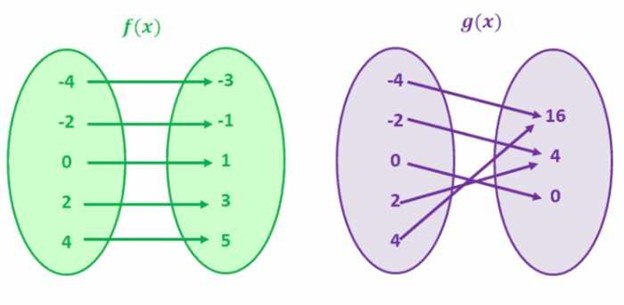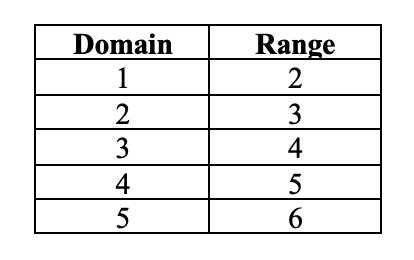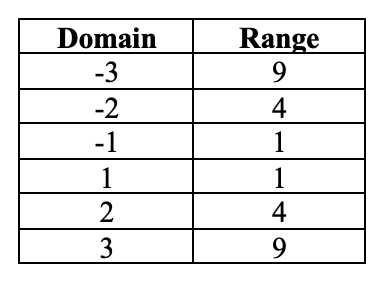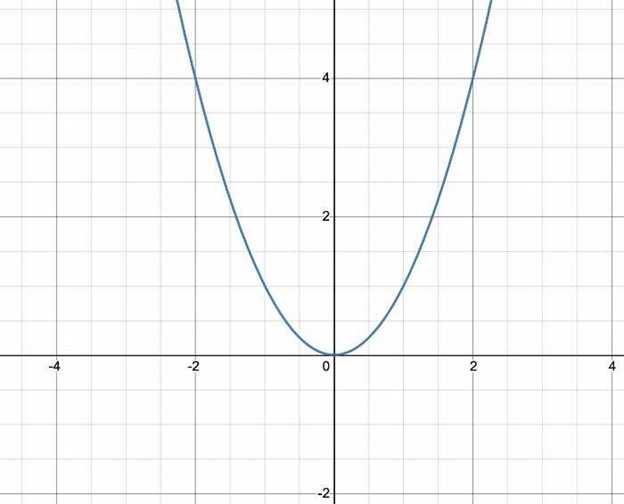One to One Functions - Graph, Examples | Horizontal Line Test
What is a One to One Function?
A one-to-one function is a mathematical function in which each input corresponds to only one output. So, for each x, there is just one y and vice versa. This signifies that the graph of a one-to-one function will never intersect.
The input value in a one-to-one function is noted as the domain of the function, and the output value is known as the range of the function.
Let's study the images below:

For f(x), each value in the left circle corresponds to a unique value in the right circle. In conjunction, any value in the right circle correlates to a unique value in the left circle. In mathematical terms, this implies every domain owns a unique range, and every range holds a unique domain. Hence, this is an example of a one-to-one function.
Here are some additional representations of one-to-one functions:
-
f(x) = x + 1
-
f(x) = 2x
Now let's examine the second example, which shows the values for g(x).
Pay attention to the fact that the inputs in the left circle (domain) do not have unique outputs in the right circle (range). Case in point, the inputs -2 and 2 have the same output, i.e., 4. In the same manner, the inputs -4 and 4 have equal output, i.e., 16. We can see that there are equivalent Y values for numerous X values. Hence, this is not a one-to-one function.
Here are additional examples of non one-to-one functions:
-
f(x) = x^2
-
f(x)=(x+2)^2
What are the characteristics of One to One Functions?
One-to-one functions have these characteristics:
-
The function owns an inverse.
-
The graph of the function is a line that does not intersect itself.
-
It passes the horizontal line test.
-
The graph of a function and its inverse are equivalent concerning the line y = x.
How to Graph a One to One Function
In order to graph a one-to-one function, you are required to determine the domain and range for the function. Let's study a straight-forward example of a function f(x) = x + 1.

Immediately after you have the domain and the range for the function, you have to plot the domain values on the X-axis and range values on the Y-axis.
How can you evaluate whether or not a Function is One to One?
To indicate if a function is one-to-one, we can apply the horizontal line test. Immediately after you chart the graph of a function, trace horizontal lines over the graph. If a horizontal line passes through the graph of the function at more than one spot, then the function is not one-to-one.
Since the graph of every linear function is a straight line, and a horizontal line will not intersect the graph at more than one place, we can also reason that all linear functions are one-to-one functions. Keep in mind that we do not apply the vertical line test for one-to-one functions.
Let's study the graph for f(x) = x + 1. Immediately after you chart the values of x-coordinates and y-coordinates, you have to examine whether a horizontal line intersects the graph at more than one point. In this case, the graph does not intersect any horizontal line more than once. This indicates that the function is a one-to-one function.

On the contrary, if the function is not a one-to-one function, it will intersect the same horizontal line multiple times. Let's examine the diagram for the f(y) = y^2. Here are the domain and the range values for the function:

Here is the graph for the function:

In this instance, the graph intersects multiple horizontal lines. Case in point, for each domains -1 and 1, the range is 1. Similarly, for each -2 and 2, the range is 4. This signifies that f(x) = x^2 is not a one-to-one function.
What is the inverse of a One-to-One Function?
Considering the fact that a one-to-one function has a single input value for each output value, the inverse of a one-to-one function also happens to be a one-to-one function. The opposite of the function essentially reverses the function.
For Instance, in the event of f(x) = x + 1, we add 1 to each value of x in order to get the output, i.e., y. The opposite of this function will remove 1 from each value of y.
The inverse of the function is known as f−1.
What are the qualities of the inverse of a One to One Function?
The characteristics of an inverse one-to-one function are the same as any other one-to-one functions. This signifies that the opposite of a one-to-one function will possess one domain for every range and pass the horizontal line test.
How do you determine the inverse of a One-to-One Function?
Determining the inverse of a function is simple. You just have to change the x and y values. Case in point, the inverse of the function f(x) = x + 5 is f-1(x) = x - 5.

As we reviewed earlier, the inverse of a one-to-one function undoes the function. Considering the original output value required adding 5 to each input value, the new output value will require us to subtract 5 from each input value.
One to One Function Practice Examples
Examine the subsequent functions:
-
f(x) = x + 1
-
f(x) = 2x
-
f(x) = x2
-
f(x) = 3x - 2
-
f(x) = |x|
-
g(x) = 2x + 1
-
h(x) = x/2 - 1
-
j(x) = √x
-
k(x) = (x + 2)/(x - 2)
-
l(x) = 3√x
-
m(x) = 5 - x
For every function:
1. Identify whether the function is one-to-one.
2. Draw the function and its inverse.
3. Find the inverse of the function numerically.
4. Specify the domain and range of both the function and its inverse.
5. Employ the inverse to determine the value for x in each formula.
Grade Potential Can Help You Learn You Functions
If you happen to be having problems trying to understand one-to-one functions or similar concepts, Grade Potential can connect you with a private teacher who can assist you. Our Queens math tutors are experienced professionals who support students just like you advance their understanding of these types of functions.
With Grade Potential, you can study at your individual pace from the convenience of your own home. Book a meeting with Grade Potential today by calling (917) 444-7990 to learn more about our teaching services. One of our representatives will get in touch with you to better ask about your requirements to set you up with the best teacher for you!




